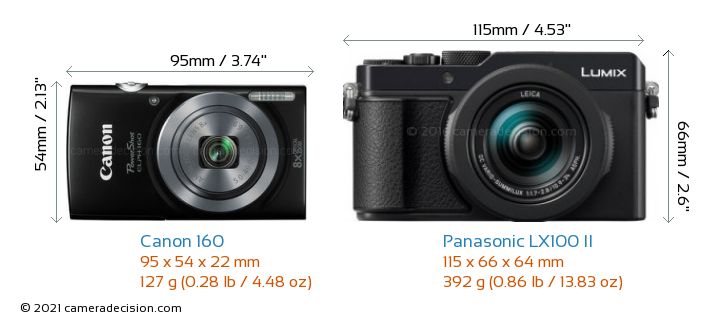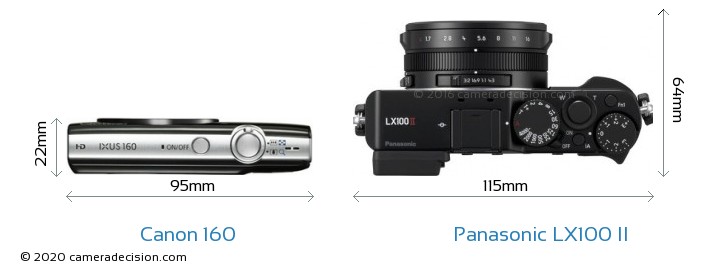Size and weight are big decision factors when you are trying to find the ideal camera for your needs.
In this section, we are going to illustrate the Canon 160 and Panasonic LX100 II side-by-side from the front, back and top in their relative dimensions. Canon 160 has external dimensions of 95 x 54 x 22 mm (3.74 x 2.13 x 0.87″) and weighs 127 g (0.28 lb / 4.48 oz) (including batteries). Panasonic LX100 II has external dimensions of 115 x 66 x 64 mm (4.53 x 2.6 x 2.52″) and weighs 392 g (0.86 lb / 13.83 oz) (including batteries).
Below you can see the front-view size comparison of the Canon 160 and the Panasonic LX100 II. Canon 160 is clearly the smaller of the two cameras. Its body is 20mm narrower, 12mm shorter and 42mm thinner than Panasonic LX100 II.
 Comparison image of the Canon 160 and the Panasonic LX100 II Size, Weight and External Dimensions - Front View
Comparison image of the Canon 160 and the Panasonic LX100 II Size, Weight and External Dimensions - Front View
Here is the back view size comparison of the Canon 160 and Panasonic LX100 II.
 Comparison image of the Canon 160 and the Panasonic LX100 II Size and Weight - Back View
Comparison image of the Canon 160 and the Panasonic LX100 II Size and Weight - Back View
Now lets look at the top view comparison of Canon 160 and Panasonic LX100 II.
 Top View Comparison image of the Canon 160 and the Panasonic LX100 II Size
Top View Comparison image of the Canon 160 and the Panasonic LX100 II Size
Weight is another important factor, especially when deciding on a camera that you want to carry with you all day.
Canon 160 is significantly lighter (265g ) than the Panasonic LX100 II which may become a big advantage especially on long walking trips.
Weather Sealing
Unfortunately neither the Canon PowerShot ELPH 160 (IXUS 160) nor Panasonic Lumix DC-LX100 II provides any type of weather sealing in their bodies, so you have to give extra care especially when you are shooting outdoors. If weather sealing is a must-have feature for you, check these sections: Top Compact Cameras with Weather Sealing
LCD Screen Size and Features
Panasonic LX100 II's 3.00" LCD screen is slightly larger than Canon 160's 2.7 screen.
Unfortunately, both cameras has fixed screens so they don't tilt or flip in directions.